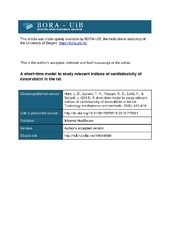A short-time model to study relevant indices of cardiotoxicity of doxorubicin in the rat
Peer reviewed, Journal article
Accepted version
Permanent lenke
https://hdl.handle.net/1956/9592Utgivelsesdato
2013-07Metadata
Vis full innførselSamlinger
Originalversjon
https://doi.org/10.3109/15376516.2013.773391Sammendrag
Aim: Short-time models (STM) to study the cardiotoxicity (acute or chronic) of doxorubicin in rats are of interest to assess protective interventions and pathways. STM promotes more ethical animal treatment with less stress, and at a lower cost compared to established longtime models (LTM). We wanted to investigate if a STM of 9 days yields the same information regarding cardiotoxicity as a LTM of 9 weeks. Methods: Male Wistar rats received identical drug administration protocols in STM and LTM. The two intervention groups (n = 6) received intraperitoneal (i.p.) injections of 2mg/kg doxorubicin every day on 5 consecutive days, with a total cumulative dose of 10mg/kg. The two control groups (n = 6), received an equivalent volume of saline injected every day on 5 consecutive days. Hearts from STM and LTM were excised and Langendorff-perfused after 9 days or 9 weeks, respectively, after the first drug injection. Cardiotoxicity was assessed in paced Langendorff hearts by release of hydrogenperoxide (H2O2) and troponin T (TnT) in effluent, by myocardial accumulation of doxorubicin and its metabolite doxorubicinol, and by physiological parameters recorded during pressure, or volume regulated perfusion. Results: In STM, hearts exposed to doxorubicin demonstrated a 15% reduction in left ventricular developed pressure (LVDP) irrespective of flow mode, and a 13% increase in aortic pressure (AoP), during volume regulated perfusion, an index of coronary resistance, compared to controls. Left ventricular end-diastolic pressure (LVEDP) was increased 72% during pressure regulated perfusion and 100% during volume regulated perfusion in STM. In LTM, hearts exposed to doxorubicin demonstrated a 40% reduction in LVDP during pressure regulated perfusion and a 20% reduction during volume regulated perfusion. LVEDP was 70% higher in doxorubicin treated hearts during pressure regulated perfusion and 80% higher during volume regulated perfusion. In addition, aortic pressure was increased 30% during volume regulated perfusion. In both STM and LTM, hearts exposed to doxorubicin demonstrated a higher H2O2 and TnT release, compared to respective controls. The difference was most pronounced in STM. Myocardial content of doxorubicin was detectable in both STM and LTM. However, doxorubicinol was only detectable in STM. Conclusion: STM is comparable to LTM to study relevant indices of cardiotoxicity of doxorubicin in rat hearts. Biochemical differences are more pronounced in STM, while contractile differences are more pronounced in LTM. STM could be a preferred model for preliminary studies of protective interventions.
